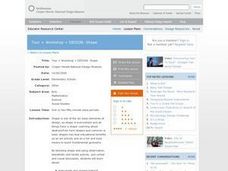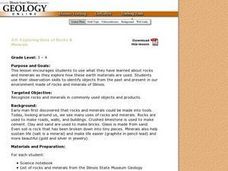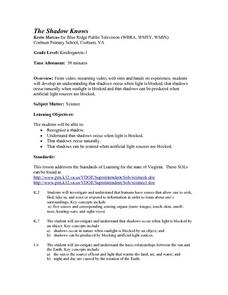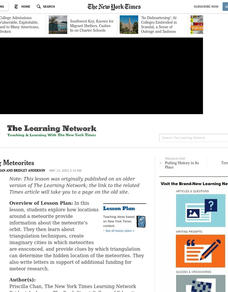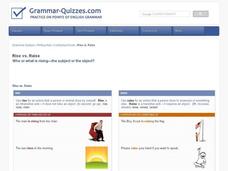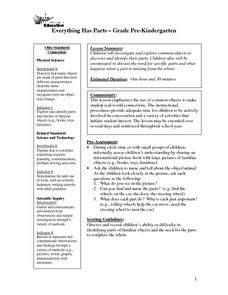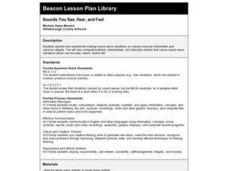Curated OER
Tour + Workshop = DESIGN: Shape
Ask elementary students to explore shapes in everyday objects. They will discuss the elements of design and describe the shapes they see in visual images. Students will then design and "build" a new 3D shape. Finally they will show and...
Curated OER
Describer-Drawer Game
What's life with out a little fun and games now and then? This game helps kids practice many different skill sets. Child one takes a card then attempts to dictate how to draw the object to child two. Child two draws an object based on...
Curated OER
4.5: Exploring Uses of Rocks & Minerals
Students, in pairs, use observation skills to identify objects from the past and present in our environment made of rocks and minerals of Illinois.
Curated OER
Counting Words in a Sentence
Combine numbers and pre-reading by counting the words in a sentence. Kindergartners begin by counting objects in the room, putting a counter down for each number. Do this a few times to get them confident with the skill before...
Curated OER
The Shadow Knows - Creating Shadows
Young learners recognize a shadow and witness how shadows occur when light is blocked. They access streamed video, standard video, and websites in order to engage in their study of how light is naturally blocked to create shadows. An...
Curated OER
Moving Day!
Eighth graders continue their geometry unit by focusing on volume. Using data, they create a spreadsheet, estimate and calculate volume. They solve real-life problems and round their answers to the hundredths place. They also practice...
Curated OER
Children's Museum of Houston - Pre/Post Classroom Activities - Nets
Students make three dimensional shapes with nets. In this nets lesson, students receive nets which they fold to make a three dimensional object. They predict what shape each net will make and verify it after making the net. They use the...
Curated OER
Beginning and Ending Consonants
Young readers explore consonant sounds. In this beginning phonics lesson, learners fill in a beginning/middle/end vertical column chart with the sounds they hear in the pictured object. Practice spelling CVC words.
Curated OER
Quadratic Equations and Functions
This comprehensive lesson plan reviews solving and graphing quadratic functions and functions of higher degree. Using the vertex form of a quadratic functions, one finds the vertex, minimum or maximum, and axis of symmetry. A few...
Curated OER
As the Kids Come and Go: Mapping a Classroom
Map the classroom with your kids to help them understand how maps work and how to read them. The lesson starts off with a story about animals living and moving around the globe, and then kids create maps of their classroom to show how...
Curated OER
Mapping Meteorites
After reading an article, "Cameras Capture a 5-Second Fireball and Its Meteorite's Secrets," space science superstars use the triangulation method to determine the location of a distant object. In-class activities and homework are...
Curated OER
Matter and Change
Bright blue slides with yellow and white font make this presentation easy for learnerrs to read. The content is a brief overview of the commonly observed physical properties of matter, focusing on the differences among solids, liquids,...
Curated OER
Monster: Compare and Contrast
Helpful for a unit on Walter Dean Myers' Monster, or any novel that you are teaching, a graphic organizer prompts learners to compare and contrast different character traits. The first box has one set of lines to jot down what two...
Curated OER
Epic Poetry: Literary Terms for Story Analysis
What do Star Wars, Indiana Jones, and The Odyssey have in common? Why, they are all epics, of course, and are presented here as examples of the literary term. If you are beginning a study of epics, consider previewing the terms included...
DK Publishing
Big, Bigger, Biggest
Which water creature is the biggest? Youngsters look at an image of a big shell, then draw a bigger shell next to it. They do the same for a big fish. Next, learners practice with the superlative as they circle the biggest duck and frog....
Baylor College
Resources and the Environment: The Math Link
Take advantage of this interdisciplinary resource and bring together topics in science, language arts, and math. Use characters and events from the story Tillena Lou's Big Adventure as a context for practicing addition and...
Infinite Dreams
Let's Create! Pottery HD
Using a potter’s wheel to make functional art is an experience not common to most people. Provide your learners with a chance to see what pottery making is all about with an app that allows them to create pots, fire them, decorate them,...
Curated OER
Confusing Words: Rise and Raise
In this confusing words: rise and raise worksheet, students read the explanations and examples for correct usage of these two words, then interactively complete 10 sentences for practice with immediate online feedback.
Curated OER
Vocabulary Review of My Things
In this vocabulary review of my things worksheet, 4th graders listen to the sentences, then interactively type in 21 vocabulary words that fills in the blank, with immediate online feedback.
Curated OER
Everything Has Parts
Students investigate and explore common objects to discover and identify their parts. They also are encouraged to discuss the need for specific parts and what happens when a part is missing from the whole.
Curated OER
Sounds You See, Hear, and Feel
Students explore and create sound wave vibrations using musical instruments and common objects. They compare/contrast and describe actions that cause sound wave vibrations that can be seen, heard, and felt.
Curated OER
Just a Little Bit
Second graders read the book, "Just a Little Bit" and work in groups weighing the same object with a scale. They then get a different unit of measurement, like paper clips, cotton balls, washers, or pennies and then figure out and record...
Curated OER
Silly Science
In this science activity, students use the dichotomous key to identify common objects listed on the sheet. Then they write the scientific name of each object.
Curated OER
Oranges and Stopwatches
Students begin to recognize that objects have many measurable attributes. They examine how to identify and accurately measure attributes of common objects. Also Students report their measurement findings.
